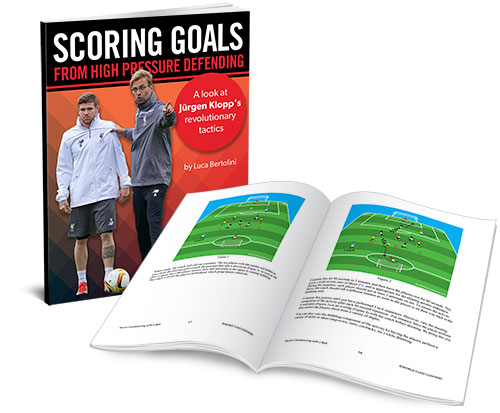- You are here:
- Home »
- defending
Tag Archives for " defending "
High Pressure to Force Long Passes
By Luca Bertolini
Liverpool have scored lots of goals this season as a direct result of their high pressure defending tactics. There are a number of benefits that can result from high pressure defending. This article takes a look at just one of the aims of those tactics…forcing the opposition into long passes from their own half of the field.
Looking at Klopp’s history as manager “no playmaker in the world can be as good as a good counter-pressing situation”; this means that a side by side passes move often requires slow build up play, and that, on the other side, the counter-pressing can create chances within seconds.
The organization behind it is the key, as Klopp’s pressing isn’t simply a closing down but a group of players all functioning as one to smother the opposition, as they look to launch a counter-attack.
The first interesting factor is that the team recognizes when they have enough players close to the ball, who are able to press the opponent with the ball and the area around it.
The players who are not involved in the pressing around the ball must ensure that a potential long kick from one of the opponents can be controlled and they must be able to press again a second receiver, if the first pressure doesn’t work. They also have to be in a position to potentially win or intercept a wrong pass from the counter pressure, to recover the possession with the chance of organizing a counterattack of their own.
All the other players placed on the other side of the ball, recover immediately and quickly, either to join the pressing swarm or to recover goal side of the ball and to be placed in a position to be one of the covering or interceptor players; if these players are in possession, usually the moves are built up with pass combinations rather than with direct counterattack.
As we already found out in the first part, an important objective of the high pressure is to close the short pass lines and to force long ones toward the midfield area; the same happens when Liverpool’s forwards are placed inside or near the opponent’s penalty area.
After the forced long pass toward the middle third, win the second times and the wandering balls.
So forcing the opposition into long passes, gives you the opportunity to win back possession of the ball and start a quick counter attack. There are many other benefits of high pressure defending too. Klopp, Guardiola, Conte and more of the world’s top coaches have figured this out.
This is article is just a short excerpt from the book Scoring More Goals Through High Pressure Defending by Luca Bertolini.
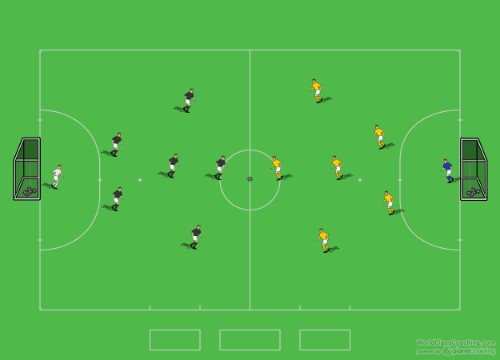
Making Play Predictable
By Sean Pearson
Area Size: Quarter or Half field (depending on age of players)
Teams: 15 – 20 mins
Players: 7 v 7
Objectives
- To stop forward penetration
- To force sideways and backwards passes
Set-Up
2 teams set up in a 2-3-1 formation in a scrimmage like scenario.

Execution
The aim for this session is for your team to work together defensively by stifling forward progression of the opposition and frustrating the other team into backwards and sideways passes until they become frustrated. Your team must stay close together to stop penetrating passing lines into the feet of players further up the field. They cut off angles so the only available pass is one of backwards or sideways.
The defending team does not have to sit right in front of their own goal for this tactic to work. It is more effective to perform it in the middle of the field. As the opposition pass wide, the defending wide midfielder gets across to pressure the player on the ball so they can’t move forwards, the rest of the team slides across, compacting that side of the field, leaving the opposite wing open. The striker drops down to stop any balls into the center of midfield.
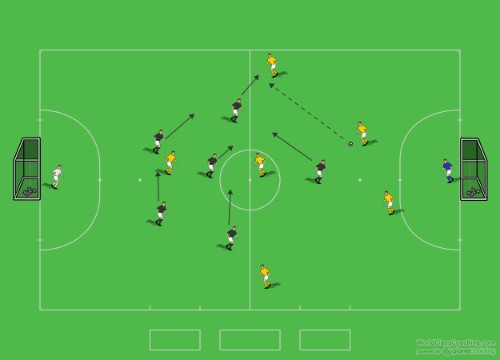
As the ball travels back to the CB the striker of the defending team presses the CB to force them to make a quick decision, again not allowing forward penetration. The obvious pass is sideways to the free CB. The team again slide into the middle to compact the area directly in front of or around the ball.
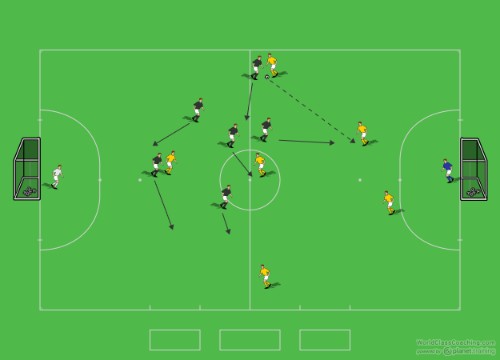
Now we have a little change of shape, because we don’t want to be so compact that passes out wide can break the defensive lines. Again the focus is to stop forward penetration by cutting off forwards passing options. As the ball travels to the opposite CB, the striker drops down to stop passes into the CM. The wide midfielder stays narrow to stop passes into the striker’s feet. The FB comes across to pressure the WM when they receive the ball and the CB and opposite WM slide across to cover and keep defensive shape.
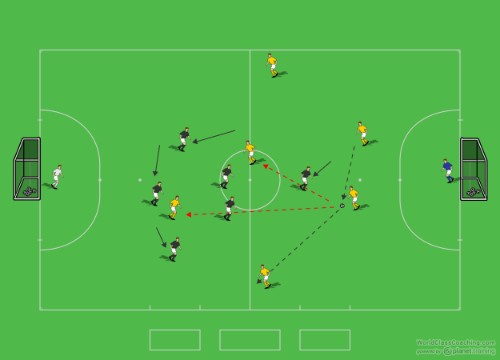
As the ball arrives to the WM the FB is close to Pressure them, the WM has dropped down to block the pass into the striker’s feet again and striker drops to stop passes into the CM again, this leaves a pass backwards to the CB as the only pass available.
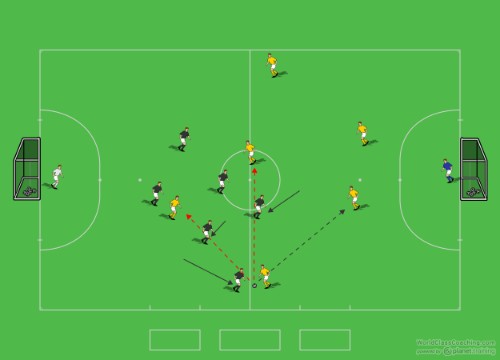
Players need to understand that they are working as a team to stop forward progression and not become individual and start to run all over the field. If players can win the ball when pressing then absolutely go for it, but the aim is to frustrate the other team going forward and giving the ball away by trying passes that are not on.
When the other team wins possession the defending team aims to frustrate and stop forward progression just like they experienced.
Variations
- Add neutrals to challenge the defending team and increase the difficulty
- Allow only 1 or 2 players to communicate to teammates to help build leaders in defense
By Sean Pearson. Sean is also the author Coaching Team Shape in the 3-3-1, Coaching Team Shape in the 4-2-3-1 and Coaching Team Shape in the 4-3-3



